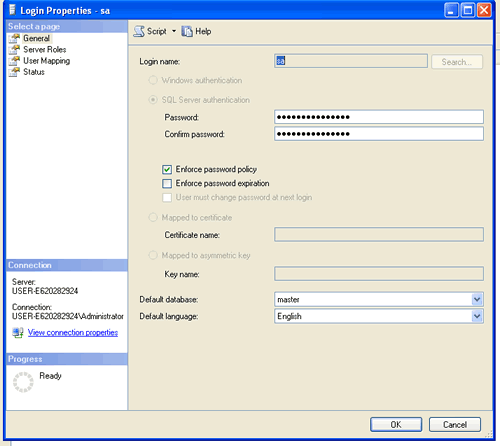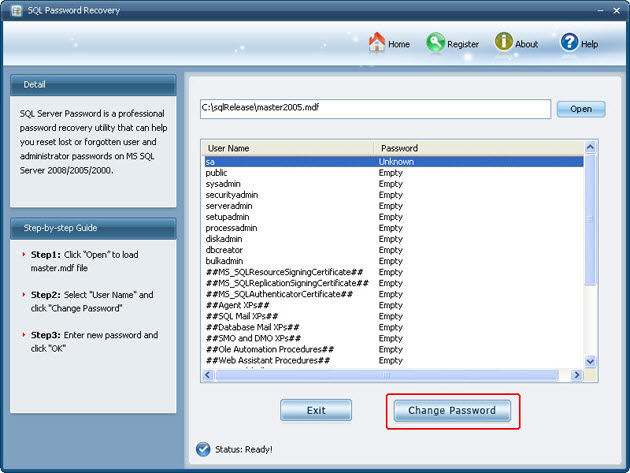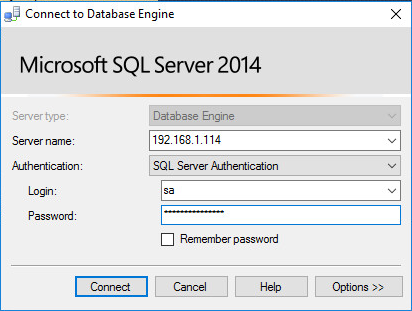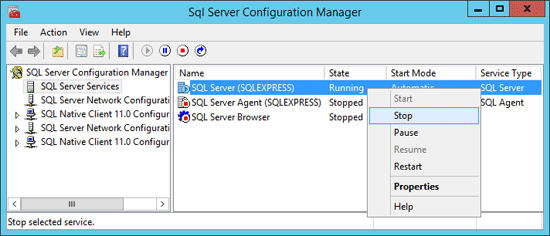- Reset Sql Password For User
- Lost Sql Server Password
- How To Reset Sql Password
- Crack Sql Server Password Changer Software
Download SQL Password Recovery for free. Reset SQL Server password with SQL password recovery software. Today password is very important to protect your database from hackers. If you daily connect with SQL Server database, for your ease you have save the password of SQL Server SA account or users account by click on remember password, in this condition you no need to put password for accessing. Then you can change the password for sa by going expanding the Server item and going to Security - Logins - Right click on sa - Click Properties Change the password here and CLICK OK. Log out, log back in as sa, after selecting SQL Server Authentication just above where you enter the user name.
SQL Server Password Changer 1.8 + crack serial keygen. January 12, 2020. Copy Download Link (paste this to your browser) Comments. Name. Email. Website. Mar 28, 2014 This Blog will dicuss some methods that will help you change the forgotten password for your SQL Server 2000/2005/2008/2012/2014 database. Microsoft® SQL Server™ is a crucial database management and analysis application used for enhancing the performance of e-commerce, data warehousing, organizational solutions and much more. Nov 07, 2015 In this the SQL administrator has a right to create a number of users with a unique username. By default, the password is same for all users and the user can change the password individually. The SQL Server stores its password as a hash in the Master.MDF file. Different version of SQL server: SQL Server 2005 code named “Yukon”.
-->This article describes how to transfer the logins and the passwords between different instances of SQL Server running on Windows.

Original product version: SQL Server
Original KB number: 918992
Introduction
Reset Sql Password For User
This article describes how to transfer the logins and passwords between different instances of Microsoft SQL Server.
Note

The instances may be on the same server or on different servers, and their versions may differ.

More information
In this article, server A and server B are different servers.
After you move a database from the instance of SQL Server on server A to the instance of SQL Server on server B, users may be unable to log in to the database on server B. Additionally, users may receive the following error message:
Login failed for user 'MyUser'. (Microsoft SQL Server, Error: 18456)
This problem occurs because you did not transfer the logins and the passwords from the instance of SQL Server on server A to the instance of SQL Server on server B.
Note
The 18456-error message also occurs due to other reasons. For additional information on these causes and potential resolutions review MSSQLSERVER_18456.
To transfer the logins, use one of the following methods, as appropriate for your situation.

Method 1: Reset the password on the destination SQL Server computer (Server B)
To resolve this issue, reset the password in SQL Server computer, and then script out the login.
Note
The password hashing algorithm is used when you reset the password.
Method 2: Transfer logins and passwords to destination server (Server B) using scripts generated on source server (Server A)
Create stored procedures that will help generate necessary scripts to transfer logins and their passwords. To do this, connect to Server A using SQL Server Management Studio (SSMS) or any other client tool and run the following script:
Note
This script creates two stored procedures in the master database. The procedures are named sp_hexadecimal and sp_help_revlogin .
In the SSMS query editor, select the Results to Text option.
Run the following statement in the same or a new query window:
The output script that the
sp_help_revloginstored procedure generates is the login script. This login script creates the logins that have the original Security Identifier (SID) and the original password.
Important
Review the information in the Remarks section below before you proceed with implementing steps on the destination server.
Steps on the destination server (Server B)
Connect to Server B using any client tool (like SSMS) and then run the script generated in Step 4 (output of sp_helprevlogin) from Server A.
Lost Sql Server Password
Remarks
How To Reset Sql Password

Crack Sql Server Password Changer Software
Review the following information before you run the output script on the instance on server B:
A password can be hashed in the following ways:
VERSION_SHA1: This hash is generated by using the SHA1 algorithm and is used in SQL Server 2000 through SQL Server 2008 R2.VERSION_SHA2: This hash is generated by using the SHA2 512 algorithm and is used in SQL Server 2012 and later versions.
Review the output script carefully. If server A and server B are in different domains, you have to change the output script. Then, you have to replace the original domain name by using the new domain name in the CREATE LOGIN statements. The integrated logins that are granted access in the new domain do not have the same SID as the logins in the original domain. Therefore, users are orphaned from these logins. For more information about how to resolve these orphaned users, see How to resolve permission issues when you move a database between servers that are running SQL Server.
If server A and server B are in the same domain, the same SID is used. Therefore, users are unlikely to be orphaned.
In the output script, the logins are created by using the encrypted password. This is because of the HASHED argument in the
CREATE LOGINstatement. This argument specifies that the password that is entered after the PASSWORD argument is already hashed.By default, only a member of the sysadmin fixed server role can run a
SELECTstatement from thesys.server_principalsview. Unless a member of the sysadmin fixed server role grants the necessary permissions to the users, the users cannot create or run the output script.The steps in this article do not transfer the default database information for a particular login. This is because the default database may not always exist on server B. To define the default database for a login, use the
ALTER LOGINstatement by passing in the login name and the default database as arguments.Sort orders on source and destination servers:
Case-insensitive server A and case-sensitive server B: The sort order of server A may be case-insensitive, and the sort order of server B may be case-sensitive. In this case, users must type the passwords in all uppercase letters after you transfer the logins and the passwords to the instance on server B.
Case-sensitive server A and case-insensitive server B: The sort order of server A may be case-sensitive, and the sort order of server B may be case-insensitive. In this case, users cannot log in by using the logins and the passwords that you transfer to the instance on server B unless one of the following conditions is true:
- The original passwords contain no letters.
- All letters in the original passwords are uppercase letters.
Case-sensitive or case-insensitive on both servers: The sort order of both server A and server B may be case-sensitive, or the sort order of both server A and server B may be case-insensitive. In these cases, the users do not experience a problem.
A login that's already in the instance on server B may have a name that is the same as a name in the output script. In this case, you receive the following error message when you run the output script on the instance on server B:
Msg 15025, Level 16, State 1, Line 1
The server principal 'MyLogin' already exists.Similarly, a login that already is in the instance on server B may have a SID that is the same as a SID in the output script. In this case, you receive the following error message when you run the output script on the instance on server B:
Msg 15433, Level 16, State 1, Line 1Supplied parameter sid is in use.
Therefore, you must do the following:
Review the output script carefully.
Examine the contents of the sys.server_principals view in the instance on server B.
Address these error messages as appropriate.
In SQL Server 2005, the SID for a login is used to implement database-level access. A login may have different SIDs in different databases on a server. In this case, the login can only access the database that has the SID that matches the SID in the
sys.server_principalsview. This problem may occur if the two databases are combined from different servers. To resolve this problem, manually remove the login from the database that has a SID mismatch by using the DROP USER statement. Then, add the login again by using theCREATE USERstatement.
References
